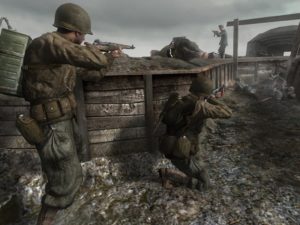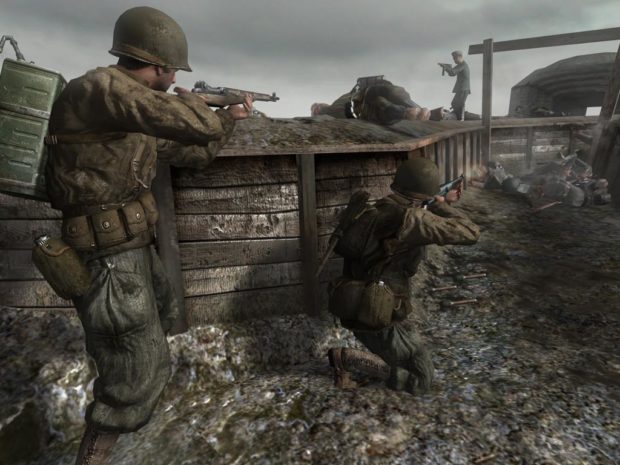
Many years ago, my friend Ray (30 years my senior) and I were at a social gathering. Ray heard me make a statement about the latest war game, Call of Duty 2, a first-person game based on World War II. Ray heard me say, embarrassingly, that playing the game “felt like I was in the war”. This was an unfortunate statement for me to make. I was foolish to say that playing a war game, even a simulation, could somehow equate to the experience of being in armed conflict. My comment was even more regrettable because Ray has brothers-in-arms who served in the Vietnam War.
I apologized to Ray and all who were in attendance at the time of my foot-in-mouth experience. But in light of Veteran’s Day,I wanted to clarify my viewpoint. After all, I actually meant well. 🙂
Video Games are immersive
In the minds of many, video games will forever be relegated to the category of “toys”, the playthings of children. It’s somewhat surprising, considering the formative years of video games where they populated bars alongside pinball machines, but that’s beside the point. Video game has the word “game” right in the name, so of course some will apply a youthful connotation to it.
But video games can be so much more than simply a “game” or a “toy”, they can be a powerful story-telling medium. Movies have long been considered an immersive experience, with carefully choreographed visuals and dramatic musical scores. Well, video games have all of that plus one more important element, you are the main character.
Let’s go back to the immersive nature of films. Steven Spielberg’s Saving Private Ryan is a movie about World War II. When it was released in theaters, the battle scenes were so realistic that many WWII veterans had flashbacks of their own wartime experiences. As immersive as movies can be, they will always be passive experiences. You only see what the director wants you to see, and when they want you to see it. Everything is scripted.
In video games, there are “scripted events” also. But for the most part, you can control your character to look wherever you want, and move wherever you want. You are the character, in a manner of speaking, and there is a connection formed with that character. But more than the sentimental bonds that can form over the duration of a game’s story (sometimes 10 or more hours), you see things through their “eyes”. So while a movie can show you the invasion of Normandy, a video game can virtually put you on the beach and force you to climb the hill to the enemy gun emplacements.
I mean really immersive
All this might sound overdramatic, but maybe it isn’t. In 2008, a new pain therapy technique was tested and demonstrated. It involved soldiers who had been seriously wounded serving during the Iraq war. The wounded were introduced to a virtual-reality game called Snow World via 3D goggles. In the game, players become immersed in a world full of snow. It’s a peaceful, fun place where the patients’ minds were transported away from the pain to a place of enjoyment. The results were obvious. Patients reported that their pain levels dropped dramatically while playing in Snow World.
Video game players often report physiological sensations associated with real experiences while playing in virtual worlds. This can be used for therapeutic value as in the case of Snow World, or for more emotional impact as in the war games.
Put yourself in someone else’s shoes
Since the 90’s, when video games started becoming more “realistic”, I’ve been fascinated by the idea of playing characters drastically different from myself. Sometimes that can mean being a muscly superhero type, but it’s more interesting when a game thrusts you into a scenario you might not choose. This can mean controlling a character who is a lost boy, looking for the meaning to his lonely life. It can mean taking the role of a young woman fighting for survival. Or in the case of war games, a new recruit doing his best to fight in a war for something much bigger than himself.
The team/squad aspects of military shooting games draws its inspiration from real, tactical warfare.
I cannot compare my experiences to actually risking or sacrificing my life in the line of duty. But the efforts of the men and women, who create these digital homages to our veterans, have given me insight that I otherwise wouldn’t have. The story campaigns often tell of actual stories fought by allied heroes. Meanwhile, the multiplayer modes demonstrate the planning and reactiveness that a soldier must have. Failure to follow orders properly can lead to defeat on both the battlefield.
In military shooting games, support classes play a major role in a team’s success. In the digital world, a medic simply drops a healing pack. But in real war, field medics keep soldiers fighting if possible with splints and bandages. Playing a “support” class in a shooting game helps to give perspective to the importance of “behind the scenes” elements of combat. The video game counterparts to these crucial military roles pale in comparison, but still point to the importance of them. School history class didn’t draw any attention to the support roles in combat zones. I only really knew about shooting and bombing. Video games helped me see that support roles are vital to the success and moral of any military campaign.
Hat in hand
I never meant to say that playing a video game was on par with serving in active duty. At the end of the day, I hit the power button and eat dinner with my wonderful family and sleep in my comfortable bed. I hope that somehow I have been able to properly convey my intent. Interactive video game experiences can be compelling, and through some of these I have grown in respect for different peoples and circumstances. The weight of military service is more than many can bear.
Thank you, veterans, for defending freedom.



